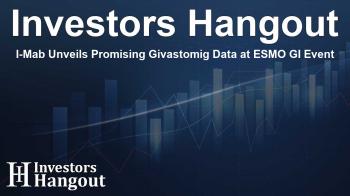I-Mab Unveils Promising Givastomig Data at ESMO GI Event

I-Mab Showcases Givastomig Efficacy at Recent Conference
In an exciting development for the cancer treatment landscape, I-Mab (NASDAQ: IMAB), a U.S.-based biotech firm, has reported promising results from its Phase 1b study on givastomig, showcased at the ESMO Gastrointestinal Cancers Congress. The abstract #388MO reveals an impressive objective response rate (ORR) of 71% across 17 patients.
Initial Findings and Future Directions
The findings indicated a remarkable 71% ORR, with a more focused 83% response seen in the ongoing dose expansion stages. Patients with lower expressions of PD-L1 and Claudin 18.2 (CLDN18.2) also displayed noteworthy responses, emphasizing the broad efficacy of givastomig in varying patient profiles.
Promising Outcomes in Study Population
As part of the study design, patients exhibited rapid and deepening responses, further bolstered by continuous safety evaluations, showing a low incidence of gastrointestinal and liver toxicities. Givastomig, in conjunction with nivolumab and mFOLFOX6 chemotherapy, is on the leading edge of immuno-oncology treatments for gastric cancers.
Company Initiatives and Stakeholder Engagements
I-Mab is not only excited about these findings but is also set to host a virtual investor event to discuss the data in greater detail. This session aims to better connect with the investment community and enhance understanding of the potential of givastomig in clinical settings.
detailed Study Insights and Metrics
The Phase 1b study, registered as NCT04900818, primarily focused on assessing the safety, efficacy, pharmacokinetics, and pharmacodynamics of givastomig. The full scope of the study targets Claudin 18.2-positive gastric cancer cases as a first-line therapy (1L).
Patient Profile Overview
In this unique trial, participants were exclusively treatment-naïve patients suffering from advanced gastric and gastroesophageal adenocarcinomas, providing a pure examination of the investigational therapy's potential. All enrolled patients are HER2-negative and have confirmed Claudin 18.2 positivity, regardless of their PD-L1 expression levels.
Key Efficacy Metrics
The efficacy results indicated that the treatment produced a 100% disease control rate among participants. Notably, the clinical data revealed a strong correlation between the levels of CLDN18.2 and response rates, marking a significant milestone in understanding the therapeutic landscape for gastric cancers.
Stay Updated with I-Mab's Journey
The safety profile of givastomig remains a focal point, as the trial reported no dose limiting toxicities and a relatively minor incidence of severe treatment-related adverse events. I-Mab continues to advocate for innovative cancer therapies, shedding light on the potential of immuno-oncology treatment avenues.
Monitoring Treatment Durability
With 8 out of 17 participants still on study treatment, the longest duration reached was an impressive 11.3 months, showcasing the treatment’s sustained impact on patients’ health outcomes.
Investor Engagement and Information
I-Mab encourages stakeholders and interested parties to engage with them during the upcoming investor event, where they will elaborate on givastomig's capabilities. Those who wish to receive updates can register for the event and access the results broadcast through the I-Mab official website.
Frequently Asked Questions
What are the findings from the I-Mab Phase 1b study on givastomig?
The study reported a 71% objective response rate and a favorable safety profile in patients with gastric cancers.
What patient demographics were involved in the givastomig trial?
Participants included treatment-naïve patients with metastatic gastric and gastroesophageal adenocarcinomas, specifically HER2-negative and Claudin 18.2-positive.
When will I-Mab present more detailed results from the study?
I-Mab will present updated findings at a virtual investor event to engage the investment community.
How does givastomig work in cancer treatment?
Givastomig functions as a bispecific antibody targeting Claudin 18.2-positive tumor cells, activating T cells through the 4-1BB signaling pathway.
What future studies are planned for givastomig?
Ongoing studies will explore its efficacy in combination with standard therapies, furthering its application in treating various solid tumors.
About The Author
Contact Kelly Martin privately here. Or send an email with ATTN: Kelly Martin as the subject to contact@investorshangout.com.
About Investors Hangout
Investors Hangout is a leading online stock forum for financial discussion and learning, offering a wide range of free tools and resources. It draws in traders of all levels, who exchange market knowledge, investigate trading tactics, and keep an eye on industry developments in real time. Featuring financial articles, stock message boards, quotes, charts, company profiles, and live news updates. Through cooperative learning and a wealth of informational resources, it helps users from novices creating their first portfolios to experts honing their techniques. Join Investors Hangout today: https://investorshangout.com/
The content of this article is based on factual, publicly available information and does not represent legal, financial, or investment advice. Investors Hangout does not offer financial advice, and the author is not a licensed financial advisor. Consult a qualified advisor before making any financial or investment decisions based on this article. This article should not be considered advice to purchase, sell, or hold any securities or other investments. If any of the material provided here is inaccurate, please contact us for corrections.

